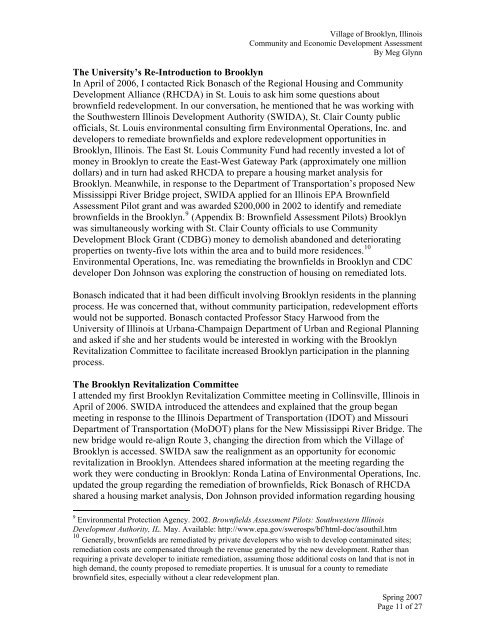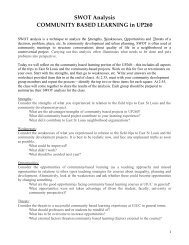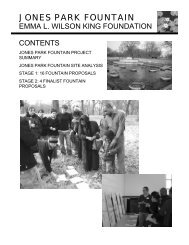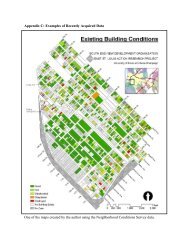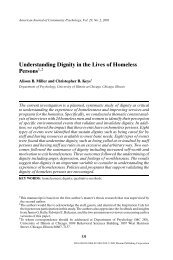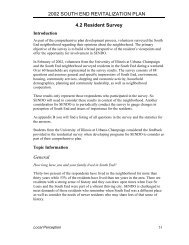Village <strong>of</strong> Brooklyn, IllinoisCommunity and Economic Development AssessmentBy Meg Glynnpopulation with the decline <strong>of</strong> area industries. 3 For a while, the town lacked even basicservices—most notably, an operating fire station. The town had a fairly large strip-clubindustry; however, with the large clubs located on I-64, the industry now consists <strong>of</strong> threeestablishments. The town has a lot <strong>of</strong> older residential buildings and is home to severalchurches. Much <strong>of</strong> the real estate is abandoned.The <strong>University</strong>’s First Involvement with BrooklynThe Program and Park Development Considerations for <strong>St</strong>ites Township Park Districtdocuments what may be the first collaboration between the <strong>University</strong> <strong>of</strong> Illinois atUrbana-Champaign and Brooklyn. 4 Brooklyn and National City organized the <strong>St</strong>itesTownship Park District in 1967. In 1968, the communities asked the <strong>University</strong> to assistthem with the development <strong>of</strong> parks and programs for the district. Thomas Brown, astudent majoring in recreation and park administration, worked with the communities toestablish the district, develop a pilot program for the administration <strong>of</strong> public recreationprograms and parks in Black communities, and establish a field instruction agency. 5 Mr.James Barker served as the first president <strong>of</strong> the park district.The <strong>East</strong> <strong>St</strong>. <strong>Louis</strong> <strong>Action</strong> <strong>Research</strong> <strong>Project</strong> (ESLARP), a program encouragingparticipatory action research in <strong>East</strong> <strong>St</strong>. <strong>Louis</strong> and the surrounding area was formed whenWyvetter Younge, chairperson <strong>of</strong> the Illinois House <strong>of</strong> Representatives’ <strong>St</strong>andingCommittee on Education Appropriations requested the development <strong>of</strong> a <strong>University</strong> <strong>of</strong>Illinois program capable <strong>of</strong> responding to the distressed City <strong>of</strong> <strong>East</strong> <strong>St</strong>. <strong>Louis</strong>. 6 In the1990s, a Neighborhood Technical Assistance Center (NTAC) was established in <strong>East</strong> <strong>St</strong>.<strong>Louis</strong>. During an ESLARP-organized alternative spring break in 1999, <strong>University</strong> <strong>of</strong>Illinois students painted interior and exterior window frames and the interior stairs andbasement floor <strong>of</strong> the Quinn Chapel A.M.E. Church and <strong>University</strong> <strong>of</strong> Tennessee studentscleaned lots and an alley near the Southern Tabernacle Missionary Baptist Church inBrooklyn. Interim NTAC director Craig Miller later met with Brooklyn Mayor RubyCook and <strong>St</strong>ites Township Supervisor Juanita Clemmons to discuss future communitydevelopment projects. 7 In 2002, Miller worked with the Lovejoy Alumni Association, analumni organization for the Lovejoy School in Brooklyn, to explore the development <strong>of</strong>an indoor recreation center. 83 Regional Housing and Community Development Alliance. 2005. Housing Development Analysis andRecommendations for the Village <strong>of</strong> Brooklyn, Illinois. September 16.4 <strong>University</strong> <strong>of</strong> Illinois at Urbana-Champaign. Office <strong>of</strong> Recreation and Park Resources. 1969. <strong>St</strong>itesTownship Park District: Community Recreation and Park <strong>Project</strong>. Champaign.5 “<strong>St</strong>ites Park District Formed.” 1970. Illinois Parks. Vol. 53. March/April. Available through IllinoisPeriodicals Online (IPO).6 Reardon, Kenneth M. 1998. “Enhancing the Capacity <strong>of</strong> Community-Based Organizations in <strong>East</strong> <strong>St</strong>.<strong>Louis</strong>,” Journal <strong>of</strong> Planning Education and <strong>Research</strong>, 17 pp. 323-333.7 Miller, Craig. 1999. Neighborhood Technical Assistance Center (NTAC): A Collaborative <strong>Project</strong> <strong>of</strong> the<strong>East</strong> <strong>St</strong>. <strong>Louis</strong> Enterprise Community (EC) and the <strong>University</strong> <strong>of</strong> Illinois at Urbana-Champaign. March.8 A 3-ring binder in the ESLARP library contains information documenting Craig Miller’s work withBrooklyn from 1999 to 2003. <strong>Project</strong>s described include plans the Lovejoy Alumni Association preparedfor a recreation center and Craig Miller’s correspondence with Pr<strong>of</strong>essor Eric Robinson (not affiliated withUIUC) who planned to work with Brooklyn school children to conduct oral history interviews.Spring 2007<strong>Page</strong> 10 <strong>of</strong> 27
Village <strong>of</strong> Brooklyn, IllinoisCommunity and Economic Development AssessmentBy Meg GlynnThe <strong>University</strong>’s Re-Introduction to BrooklynIn April <strong>of</strong> 2006, I contacted Rick Bonasch <strong>of</strong> the Regional Housing and CommunityDevelopment Alliance (RHCDA) in <strong>St</strong>. <strong>Louis</strong> to ask him some questions aboutbrownfield redevelopment. In our conversation, he mentioned that he was working withthe Southwestern Illinois Development Authority (SWIDA), <strong>St</strong>. Clair County public<strong>of</strong>ficials, <strong>St</strong>. <strong>Louis</strong> environmental consulting firm Environmental Operations, Inc. anddevelopers to remediate brownfields and explore redevelopment opportunities inBrooklyn, Illinois. The <strong>East</strong> <strong>St</strong>. <strong>Louis</strong> Community Fund had recently invested a lot <strong>of</strong>money in Brooklyn to create the <strong>East</strong>-West Gateway Park (approximately one milliondollars) and in turn had asked RHCDA to prepare a housing market analysis forBrooklyn. Meanwhile, in response to the Department <strong>of</strong> Transportation’s proposed NewMississippi River Bridge project, SWIDA applied for an Illinois EPA BrownfieldAssessment Pilot grant and was awarded $200,000 in 2002 to identify and remediatebrownfields in the Brooklyn. 9 (Appendix B: Brownfield Assessment Pilots) Brooklynwas simultaneously working with <strong>St</strong>. Clair County <strong>of</strong>ficials to use CommunityDevelopment Block Grant (CDBG) money to demolish abandoned and deterioratingproperties on twenty-five lots within the area and to build more residences. 10Environmental Operations, Inc. was remediating the brownfields in Brooklyn and CDCdeveloper Don Johnson was exploring the construction <strong>of</strong> housing on remediated lots.Bonasch indicated that it had been difficult involving Brooklyn residents in the planningprocess. He was concerned that, without community participation, redevelopment effortswould not be supported. Bonasch contacted Pr<strong>of</strong>essor <strong>St</strong>acy Harwood from the<strong>University</strong> <strong>of</strong> Illinois at Urbana-Champaign Department <strong>of</strong> Urban and Regional Planningand asked if she and her students would be interested in working with the BrooklynRevitalization Committee to facilitate increased Brooklyn participation in the planningprocess.The Brooklyn Revitalization CommitteeI attended my first Brooklyn Revitalization Committee meeting in Collinsville, Illinois inApril <strong>of</strong> 2006. SWIDA introduced the attendees and explained that the group beganmeeting in response to the Illinois Department <strong>of</strong> Transportation (IDOT) and MissouriDepartment <strong>of</strong> Transportation (MoDOT) plans for the New Mississippi River Bridge. Thenew bridge would re-align Route 3, changing the direction from which the Village <strong>of</strong>Brooklyn is accessed. SWIDA saw the realignment as an opportunity for economicrevitalization in Brooklyn. Attendees shared information at the meeting regarding thework they were conducting in Brooklyn: Ronda Latina <strong>of</strong> Environmental Operations, Inc.updated the group regarding the remediation <strong>of</strong> brownfields, Rick Bonasch <strong>of</strong> RHCDAshared a housing market analysis, Don Johnson provided information regarding housing9 Environmental Protection Agency. 2002. Brownfields Assessment Pilots: Southwestern IllinoisDevelopment Authority, IL. May. Available: http://www.epa.gov/swerosps/bf/html-doc/asouthil.htm10 Generally, brownfields are remediated by private developers who wish to develop contaminated sites;remediation costs are compensated through the revenue generated by the new development. Rather thanrequiring a private developer to initiate remediation, assuming those additional costs on land that is not inhigh demand, the county proposed to remediate properties. It is unusual for a county to remediatebrownfield sites, especially without a clear redevelopment plan.Spring 2007<strong>Page</strong> 11 <strong>of</strong> 27
- Page 1 and 2: Village of Brooklyn, IllinoisCommun
- Page 3 and 4: Village of Brooklyn, IllinoisCommun
- Page 5 and 6: Village of Brooklyn, IllinoisCommun
- Page 7 and 8: Village of Brooklyn, IllinoisCommun
- Page 9: I. Institutional Memory: the Histor
- Page 13 and 14: Village of Brooklyn, IllinoisCommun
- Page 15 and 16: Village of Brooklyn, IllinoisCommun
- Page 17: Village of Brooklyn, IllinoisCommun
- Page 21 and 22: Village of Brooklyn, IllinoisCommun
- Page 23 and 24: Village of Brooklyn, IllinoisCommun
- Page 25 and 26: Village of Brooklyn, IllinoisCommun
- Page 27: Village of Brooklyn, IllinoisCommun


